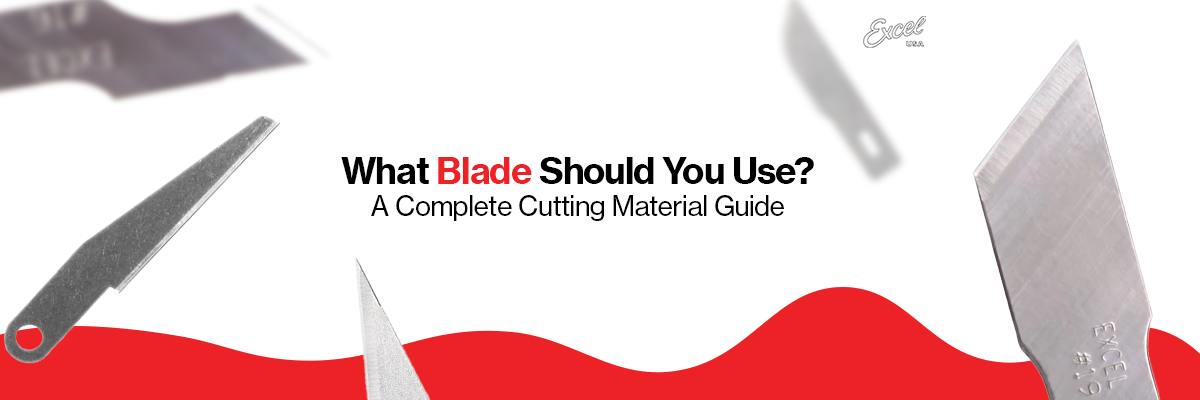
What Blade Should You Use? A Complete Cutting Material Guide
Choosing the right blade isn’t just about sharpness — it’s about precision, safety, efficiency, and the quality of your final product. Whether you’re crafting, model building, or working on an industrial task, using the wrong blade can ruin your project or waste materials. That’s why we created this complete cutting material guide to help you match the best blade to the material at hand.
In this guide, we’ll cover:
- The most common blade types
- Recommended blades for specific materials
- How to improve safety and results with the right tool
- Blade maintenance and when to replace your blades
Types of Blades You Should Know
Before diving into materials, it’s important to know the basic types of cutting blades used in crafting and industrial applications:
- Utility blades: Versatile and used for general cutting.
- Precision/craft blades: Designed for detailed work like paper or vinyl.
- Scalpel blades: Ultra-fine for extremely accurate cuts in tight areas.
- Chisel blades: Good for carving or scraping flat surfaces.
- Curved blades: Ideal for sweeping cuts on soft material.
- Serrated blades: Designed for tough materials like rubber or rope.
- Hook blades: Perfect for scoring or cutting through insulation and roofing material.
Explore all Excel Blades options here
Best Blades for Each Material
Here’s your go-to list for matching blade types to cutting materials for precision and clean results:
1. Paper & Cardstock
- Recommended Blade: #11 Precision Blade
- Use For: Papercrafts, card making, stenciling
Shop the Excel Blades #11 Precision Blade
2. Foam Board, EVA Foam, Craft Foam
- Recommended Blade: #20018 K18 Knife with #11 blade or a utility knife with snap-off blade
- Use For: Cosplay builds, signage, model terrain
Top Tools for Cosplay Foam Builds
3. Vinyl & Stickers
- Recommended Blade: #16 Stencil Blade
- Use For: Decal cutting, sign making, automotive wrap
4. Leather
- Recommended Blade: Curved or chisel blade
- Use For: Leathercraft, belt making, patches
5. Plastic Sheets (e.g., styrene, acrylic)
- Recommended Blade: Heavy-duty utility blade or scoring blade
- Use For: Model kits, architectural models
6. Balsa Wood & Soft Woods
- Recommended Blade: Chisel blade or #22 wide blade
- Use For: Model airplanes, dollhouse furniture
7. Rubber, Silicone, Gasket Material
- Recommended Blade: Serrated or heavy-duty hook blade
- Use For: Automotive repairs, sealing projects
8. Fabric
- Recommended Blade: Rotary cutter or sharp curved blade
- Use For: Quilting, fashion design, crafts
9. Mat Board
- Recommended Blade: #11 or #2 heavy-duty blade
- Use For: Framing, collage art, signage
10. Rope, Carpet, Heavy Materials
- Recommended Blade: Hook blade or serrated edge blade
- Use For: Flooring projects, industrial crafts
Tips for Safe & Accurate Cutting
- Use a self-healing cutting mat to protect your surface and blade
- Always cut away from your body
- Replace dull blades frequently — they’re more dangerous than sharp ones
- Keep spare blades in a safe, organized container
- Use a metal ruler for straight-edge cutting
Find the right cutting mat here
How Often Should You Replace Your Blades?
Blade life depends on your material and frequency of use. Here are general signs that it’s time to switch:
- The blade is dragging or skipping
- You’re seeing frayed or rough edges
- More pressure is needed to cut
- Blade is visibly chipped or rusty
Conclusion: Match the Blade to the Job
From precision hobby knives to heavy-duty utility blades, each cutting task demands the right blade. Using the wrong one can lead to waste, injuries, or low-quality results. By following this cutting material guide, you’ll be equipped to make smarter, safer, and more efficient cuts — no matter what project lies ahead.
Subscribe to our newsletter for more expert tips, DIY projects, and the latest in cutting tool innovation.
You May Also Watch: Excel Blades #11 Angled Craft Blades
